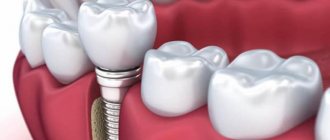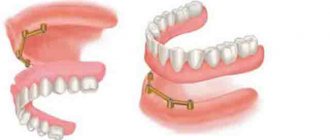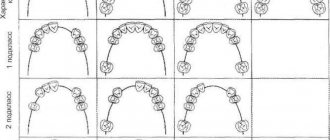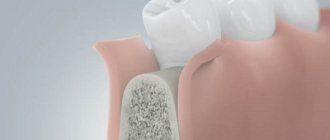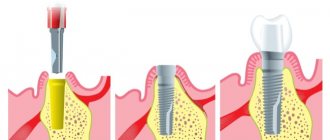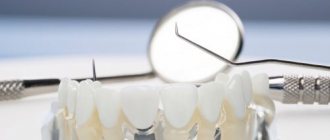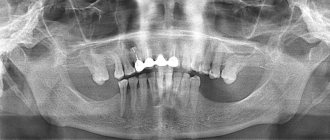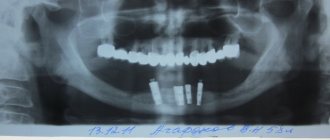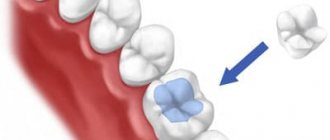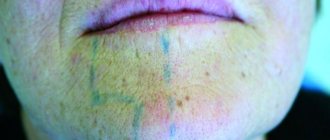Alveoloplasty methods
Correction of the alveolar process
It is used before the start of rational prosthetics, for the convenience of the patient while wearing a removable denture.
Relocation of the inferior alveolar nerve
The operation is performed when there is not enough space to place an implant; this situation often occurs in the lower jaw.
Graft transplant
Transplantation - increasing the volume of the mucous membrane or bone tissue. The need for this method arises after the removal of teeth or anatomical features of the body in order to comply with the conditions for implantation.
Gingivosteoplasty
This method is used for periodontal diseases with varying degrees of severity. Gingivosteoplasty is intended to correct gum recession.
Alveolar process atrophy
Rice. 1a
Rice. 1b
Rice. 1c
Rice. 2a
Rice. 2b
Rice. 2c
Rice. 2d
Rice. 3a
Rice. 3b
Rice. 3c
Rice. 3d
Rice. 3e
Rice. 4a
Rice. 4b
Rice. 4c
Rice. 5a
Rice. 5b
Rice. 5c
Rice. 5d
Rice. 6a
Rice. 6b
Rice. 6s
Rice. 7
Loss of bone tissue in the alveolar processes of the jaws often occurs due to the loss of teeth, as well as their primary absence. Bone tissue deficiency accompanies chronic forms of periodontitis, which may be a consequence of internal pathology of the body. This condition causes cosmetic disturbances, often complicates full dental prosthetics, and in some cases makes it impossible to install dental implants. Elimination of atrophy of the alveolar processes of the jaws (restoration of lost structures) is possible through transplantation (grafting) of bone tissue borrowed from other parts of the body. The use of artificial drugs produced by the domestic and foreign medical industry, such as kollapan, collaost, bioss, etc., is ineffective, since they do not contain a single living osteogenic cell. As you know, the bone tissue of the jaw bones consists of a compact and spongy part. They include bone cells (osteocytes, osteoblasts, etc.) and intercellular substance, due to which the strength properties necessary to withstand the chewing load without traumatic damage are determined (in the molar zone an average of 60-80 kg, in the incisor zone - 30- 40 kg), and spongy substance and bone marrow cells. Bone tissue is richly supplied with blood, since osteocytes die within 2 hours if they are located further than 0.2 mm from a blood vessel. Metabolic processes constantly occur in its thickness, ensuring its trophism (nutrition) and the constancy of the internal environment, as well as processes of bone remodeling (atrophy and replacement of non-viable tissue, including restructuring of the structure depending on changes in load (direction and force). Based on the above, it becomes It is clear that the above drugs are not fully able to replace missing bone structures. After they are placed in the body, they undergo resorption, and the body is forced to direct its energy to get rid of resorption products. These processes not only require large energy costs (due to which patients after such type of operations, they complain for a long time of general weakness and malaise), but also subject to resorption of the bone tissue surrounding the implant used, which inevitably leads to even greater loss. Foreign bone tissue (allogeneic, cattle, etc.) after placement in bone defects is rejected or resorbed (dissolves), since it does not contain viable bone structures, and therefore it is impossible to achieve the desired result. The most effective method of restoring the lost structures of the alveolar parts of the jaw bones (used in our clinic) is the transplantation of osteogenic tissue (immature bone tissue) grown in the thickness of the patient’s iliac crest. This technology does not have the above disadvantages, since the transformation of transplanted tissue in defects is possible only into bone structures. It was established experimentally, clinically and radiologically that the transplanted osteogenic tissue in bone defects was rebuilt to the formation of an organotypic regenerate. This transplant material, due to its inductive properties due to the high content of low-differentiated bone elements of mesenchymal origin, as well as the properties of diffuse nutrition, anaerobic glycolysis, resistance to hypoxia conditions, appositional and interstitial growth, was not resorbed in defects and its cells actively participated in the processes of reparative osteogenesis .
Diagnostics
At the initial stage, the doctor will listen to the patient’s complaints and find out the mechanism of injury. Next, the specialist proceeds to an examination, which allows him to obtain a lot of valuable information. In severe displaced fractures, the diagnosis can be made already at this stage.
The mobility of fragments in a complete fracture can be determined by palpation. Based on these data, the location and direction of the fracture can be assumed.
Accurate diagnosis is carried out on the basis of radiographic examination. The image clearly visualizes the fracture line and the direction of displacement of the fragments. Computed tomography can provide more detailed information. This technique makes it possible to take pictures of layer-by-layer sections of the damaged area, as well as determine the condition of the soft tissues and the position of the fragments relative to other anatomical structures.
When a fracture occurs in the area of the alveolus, the teeth suffer. The dentist must determine which ones can be attempted to be preserved. For this purpose, the viability of the pulp is determined using EDI. In doubtful cases, the study is repeated after 1-2 weeks; the pulp may undergo necrosis or restore viability. Based on the results obtained, further tactics are determined.
